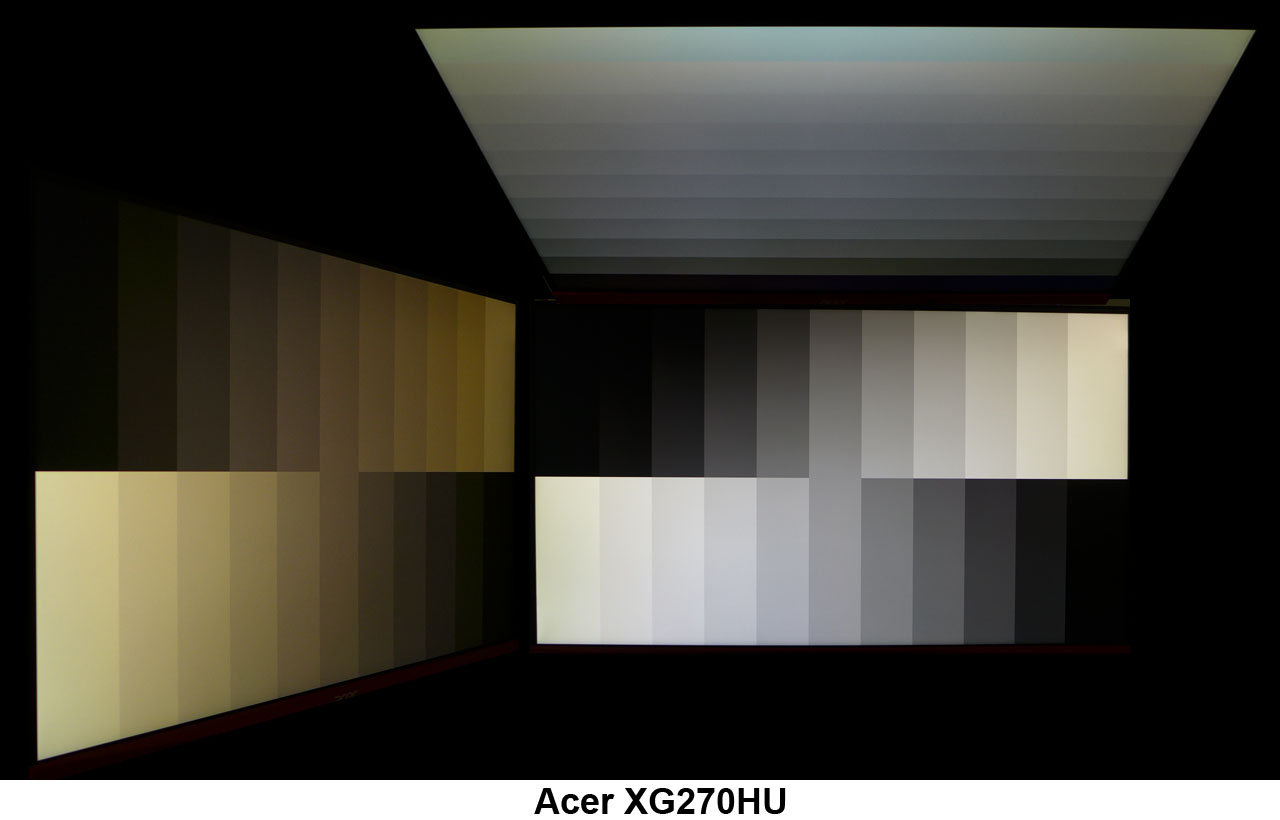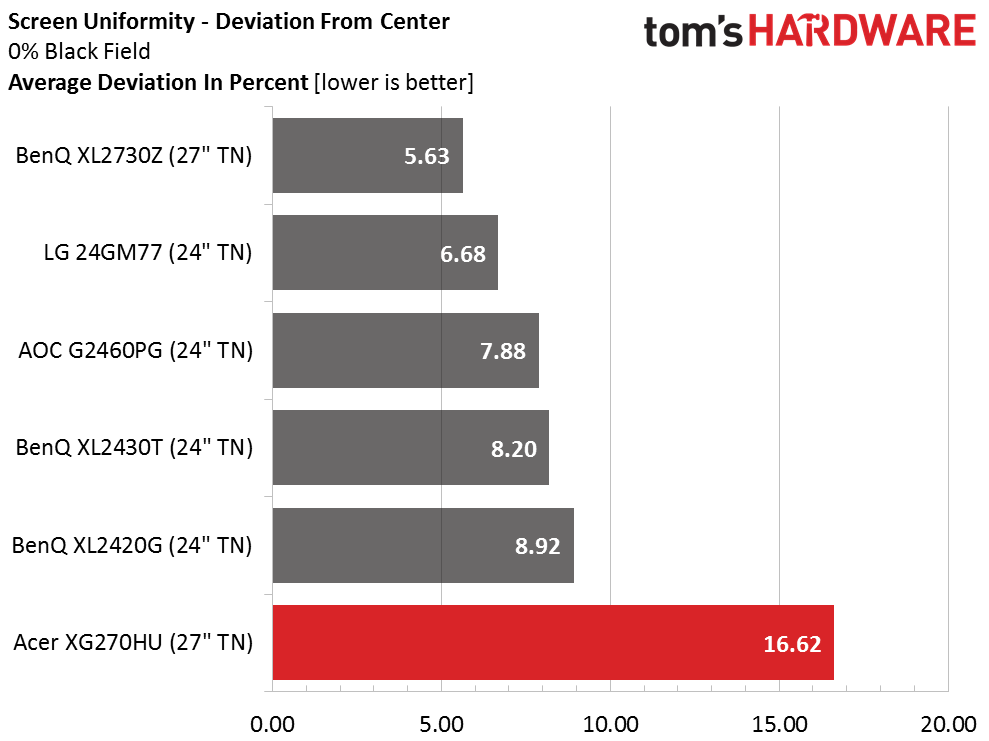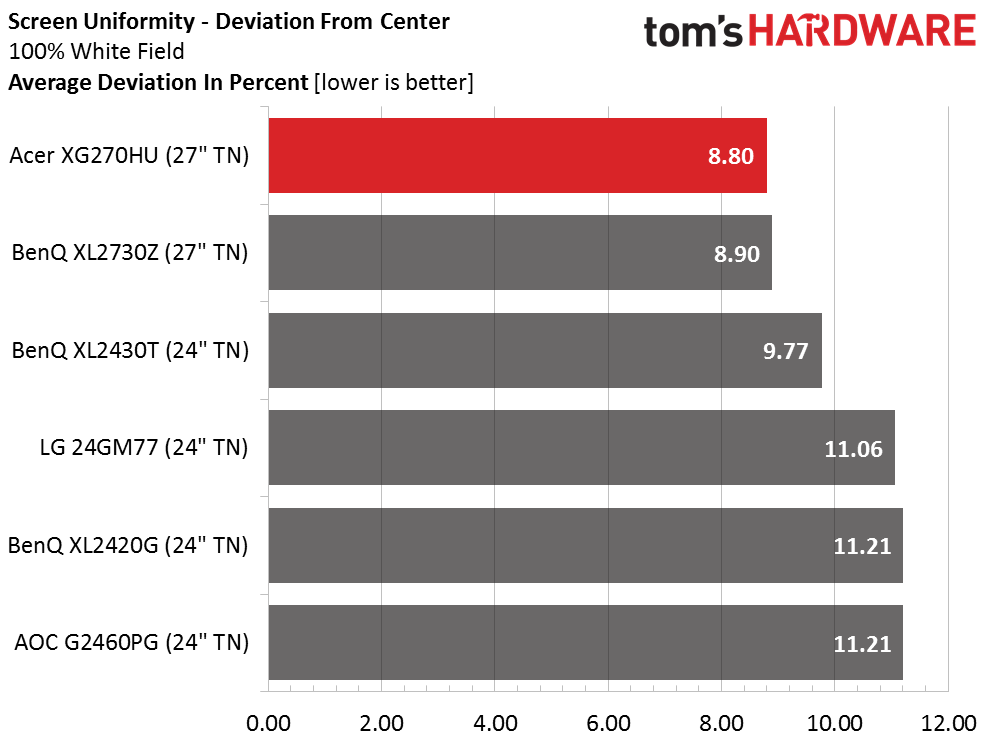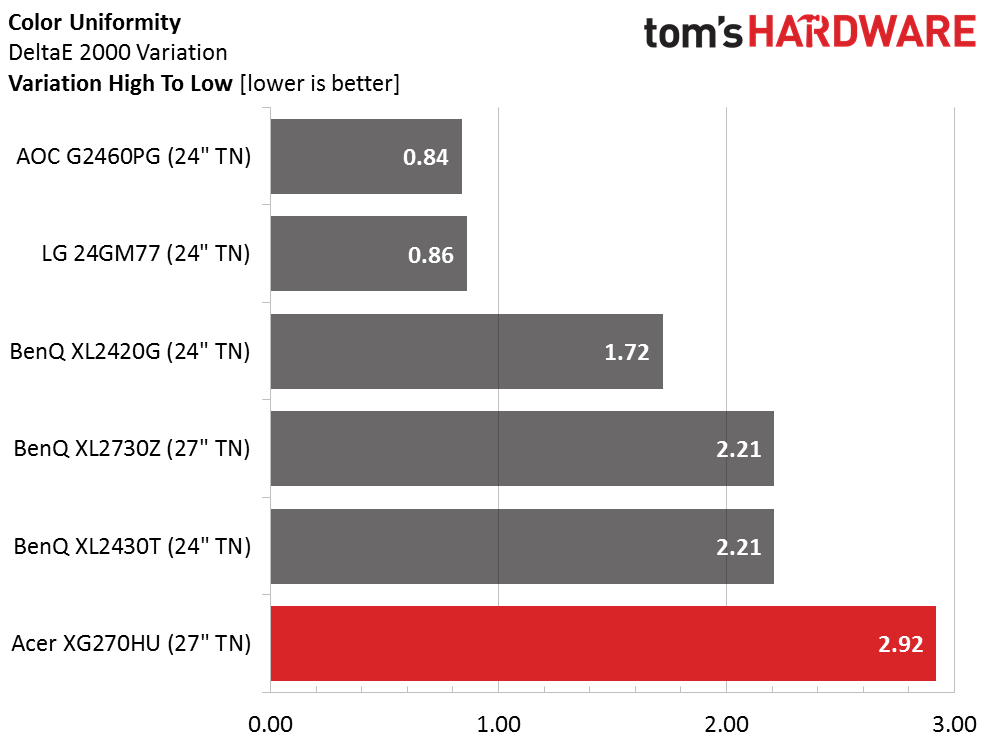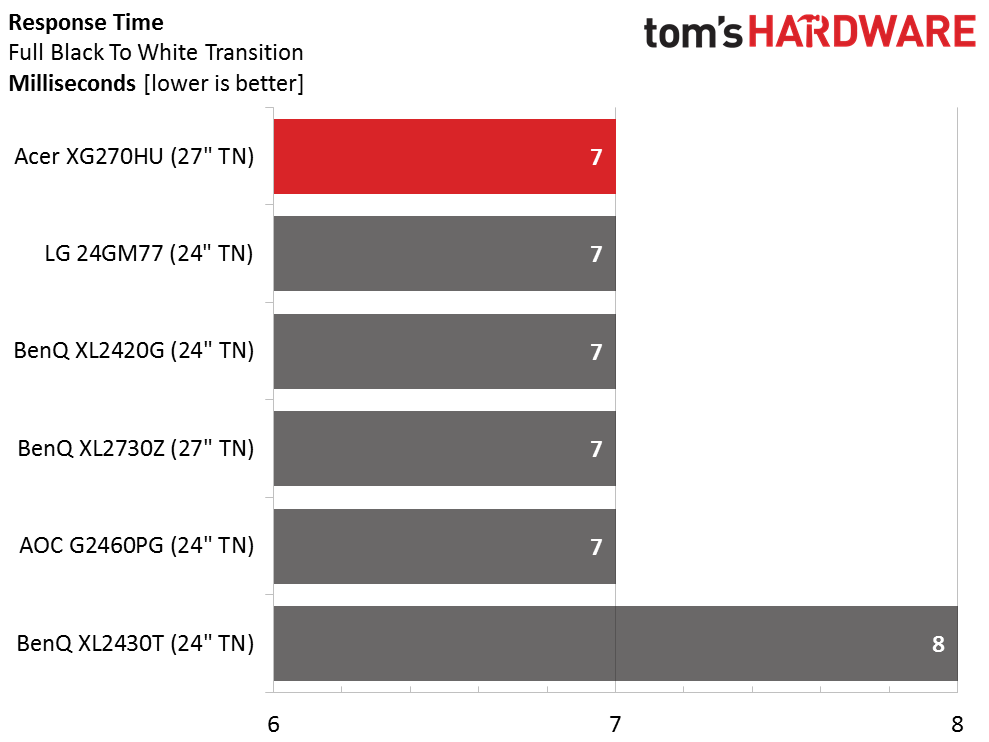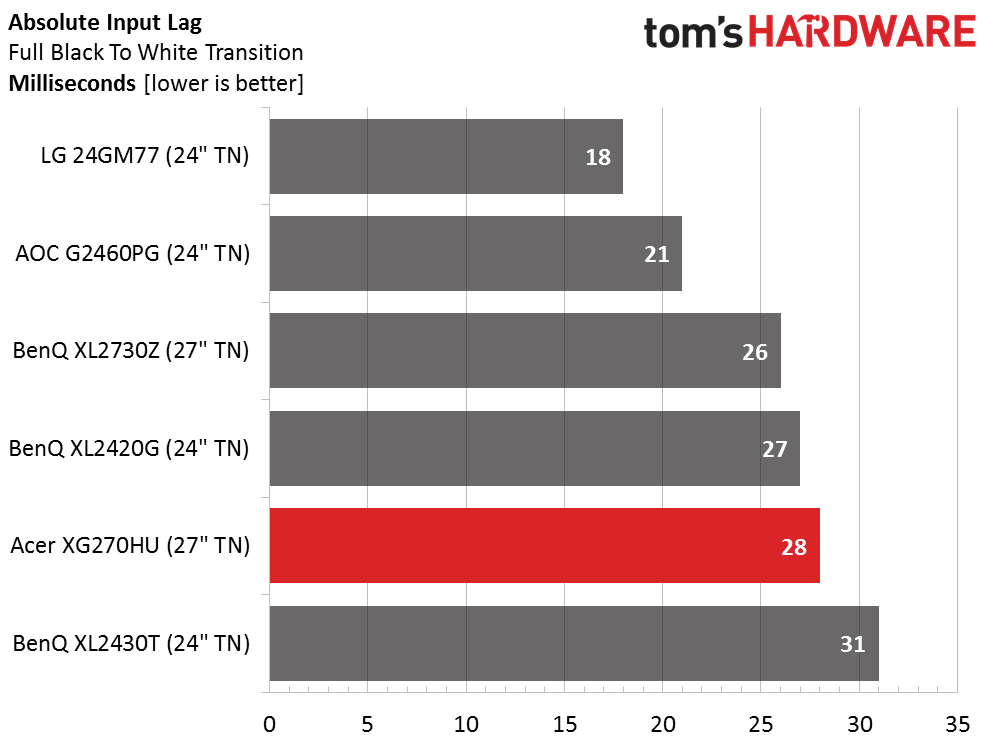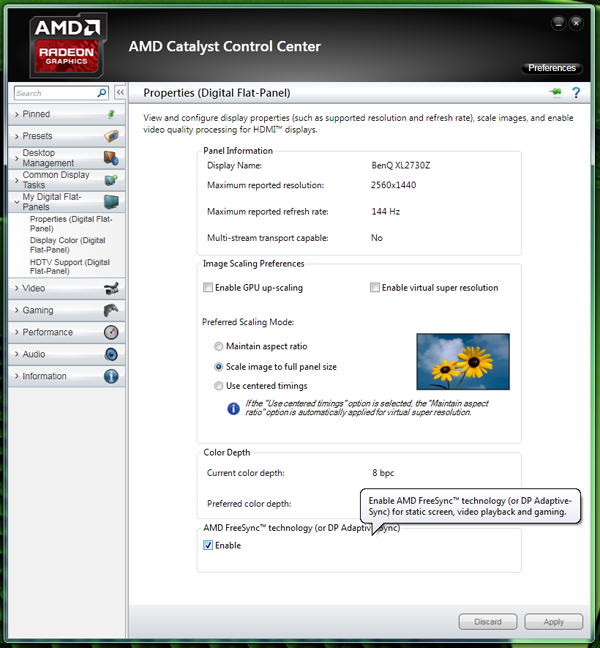Acer XG270HU 27-inch FreeSync Monitor Review
We’ve had G-Sync monitors for many months now, but AMD fans had to wait for FreeSync screens. Today we’re looking at Acer’s 27-inch QHD XG270HU.
Why you can trust Tom's Hardware
Viewing Angles, Uniformity, Response And Lag
To learn how we measure screen uniformity, please click here.
This is usually the place where we lament the lack of IPS panels in the gaming segment. With a few exceptions, TN is still the tech of choice for a fast screen. By using the latest AU Optronics part, however, Acer delivers one of the best twisted-nematic monitors we’ve tested. You won’t mistake it for IPS or VA, but it’s rare that we can see all of the dark steps in both the side and top-down photos. While the color shift is obvious, very little detail is lost when moving off-center in the horizontal plane. It's weaker vertically, but you can see the steps there too. You won’t have to feel like you’re settling for TN as much with the XG270HU.
Screen Uniformity: Luminance
Although the numerical result in our black test is disappointing, it’s almost entirely due to a center-screen hotspot. The surrounding zones are much more uniform. There is no visible patchiness or light bleed, just a barely visible glow in the middle. And it’s not something that will bother you in real-world use.
Here’s the white field measurement:
The white field test shoots the XG270HU to the top of the group with an 8.8% result. There are no visible bright or dim areas.
Screen Uniformity: Color
If a monitor scores over three in this test, it means you can see slight color tint in parts of the 80-percent white field pattern. We didn't observe any, but our i1 Pro spectrophotometer did. It mainly picked up errors along the top of the screen.
Pixel Response And Input Lag
To perform these tests, we use a high-speed camera that shoots at 1000 frames per second. Analyzing the video frame-by-frame allows us to observe the exact time it takes to go from a zero percent signal to a 100% white field.
Get Tom's Hardware's best news and in-depth reviews, straight to your inbox.
Testing a 144Hz gaming monitor means we can’t use the AccuPel generator, which is limited to 60Hz. So, we hooked the XG270HU up to a Radeon R9 285-equipped PC and filmed a mouse movement that triggers the field pattern’s appearance. Since this is less precise than using the generator, we average five measurements. Here’s the screen draw result:
With a panel this responsive, the absence of blur reduction isn't really missed. All of the screens in this group have it except for Acer's. And as you can see, the contenders present near-identical performance. Moreover, we observe no evidence of FreeSync slowing panel response. It was turned on for every benchmark.
Here are the lag results:
The LG 24GM77 is likely to be our input lag champ for the foreseeable future. Still, 10 extra milliseconds are hardly a deal-breaker. Playing FPS titles that require hair-trigger reflexes is great on the XG270HU. And with the super-smooth motion provided by FreeSync, you’ll never want to go back to a fixed-refresh monitor.
FreeSync
As with our previous review of the BenQ XL2730Z, enabling FreeSync is simply a matter of checking the appropriate box in AMD's Catalyst Control Center.
Once we did this, the feature worked perfectly in the games we tried. There were no tears present and we could leave the refresh rate at 144Hz. Most G-Sync monitors top out at 120Hz (unless you turn rate-matching off) so this is a plus for FreeSync, especially as graphics cards achieve higher frame rates.
Current page: Viewing Angles, Uniformity, Response And Lag
Prev Page Color Gamut And Performance Next Page Conclusion
Christian Eberle is a Contributing Editor for Tom's Hardware US. He's a veteran reviewer of A/V equipment, specializing in monitors. Christian began his obsession with tech when he built his first PC in 1991, a 286 running DOS 3.0 at a blazing 12MHz. In 2006, he undertook training from the Imaging Science Foundation in video calibration and testing and thus started a passion for precise imaging that persists to this day. He is also a professional musician with a degree from the New England Conservatory as a classical bassoonist which he used to good effect as a performer with the West Point Army Band from 1987 to 2013. He enjoys watching movies and listening to high-end audio in his custom-built home theater and can be seen riding trails near his home on a race-ready ICE VTX recumbent trike. Christian enjoys the endless summer in Florida where he lives with his wife and Chihuahua and plays with orchestras around the state.
-
rdc85 Look goods,Reply
hope they can make 144hz IPS "Freesync" monitor...
24" preferred.. 27" just to big for me.. -
eklipz330 "In the case of the XG270HU, its frame rate range is 30-144Hz, which means you can benefit from FreeSync down to 30 FPS."Reply
my god that is wonderful -
ubercake Reply"In the case of the XG270HU, its frame rate range is 30-144Hz, which means you can benefit from FreeSync down to 30 FPS."
The first freesync monitor with such a range. This is great for competition!!!
my god that is wonderful
I also like the fact these freesync monitors are not limited to a single DP input.
Now I feel like I have a choice again. AMD corrected their FCAT issues I had been complaining about for years and now freesync? I may head back to team red with the next gen. This is good stuff. How are the drivers lately? -
wtfxxxgp Very sexy monitor. That IPS version is also supposed to be QHD... That's going to be pricey for sure, but at least it's the start of good things to comeReply
-
wtfxxxgp ReplyLook goods,
hope they can make 144hz IPS "Freesync" monitor...
24" preferred.. 27" just to big for me..
Seriously? 27" 1440p is the SWEET SPOT. -
UncleVesper Reply"In the case of the XG270HU, its frame rate range is 30-144Hz, which means you can benefit from FreeSync down to 30 FPS."
my god that is wonderful
It figures Tom's Hardware does not actually do a full review of their products. The FreeSync range they just took for granted in what they were told. According to GURU3D, they experienced tearing this monitor < 40 FPS, so the minimum range is NOT 30 but 40 HZ.
http://www.guru3d.com/articles_pages/amd_freesync_review_with_the_acer_xb270hu_monitor,12.html -
UncleVesper Link cut off, this was the conclusion: "We did noticed on the ACER screen that at low sub 35 FPS screen tearing was back, which was disappointing. From what we learned, the ACER dynamic range starts at 40Hz, and thus so will FreeSync. If you cannot achieve such a framerate then you need to tweak image quality in such a manner that it stays above the minimum dynamic range. But FreeSync at 40+ FPS is as good as it is at 60 FPS, that is a fact."Reply -
Wisecracker Reply16039451 said:"In the case of the XG270HU, its frame rate range is 30-144Hz, which means you can benefit from FreeSync down to 30 FPS."
my god that is wonderful
Yup.
The first OEMs to seriously target entry-level and 'mainstream' 30Hz+ at a respectable size and resolution are sitting on gold mines. Hopefully, it will happen sooner rather than later.
If Intel gets behind it, it's a done deal. Being the big dog with DX12 on the immediate horizon, and with their investment made into integrated graphics, it is a natural extension to bring DP to great, inexpensive motherboards.
I'd love to see some gaming reviews at the lower-end. Let us see the experience with a $130 APU.
-
singemagique ReplyVery sexy monitor. That IPS version is also supposed to be QHD... That's going to be pricey for sure, but at least it's the start of good things to come
Yep, the XB270HU is 1440p, IPS, 144hz, 4ms, GSync. I picked up two last month from Amazon at $738. They are excellent panels and the best monitors I have used outside of professional monitors. -
quilciri Why, oh why, oh why doesn't it have a VESA mount? You were so close to the perfect monitor, Acer.Reply
